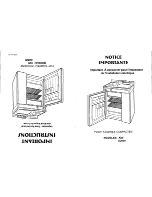
6
3. Determine the length of copper tubing you need. Measure
from the connection on the lower left rear of refrigerator to the
water pipe. Add 7 ft (2.1 m) to allow for cleaning. Use
¹⁄₄
"
(6.35 mm) O.D. (outside diameter) copper tubing. Be sure both
ends of copper tubing are cut square.
4. Using a grounded drill, drill a
¹⁄₄
" (6.35 mm) hole in the cold
water pipe you have selected.
5. Fasten shutoff valve to cold water pipe with pipe clamp. Be
sure outlet end is solidly in the
¹⁄₄
" (6.35 mm) drilled hole in the
water pipe and that washer is under the pipe clamp. Tighten
packing nut. Tighten the pipe clamp screws carefully and
evenly so washer makes a watertight seal. Do not overtighten
or you may crush the copper tubing, especially if soft (coiled)
copper tubing is used. Now you are ready to connect the
copper tubing.
6. Slip compression sleeve and compression nut on copper
tubing as shown in the diagram. Insert the end of the tubing
into the outlet end of the shutoff valve as far as it will go.
Screw the compression nut onto the outlet end with an
adjustable wrench. Do not overtighten.
7. Place the free end of the tubing into a container or sink, turn
ON main water supply and flush out tubing until water is clear.
Turn OFF the shutoff valve on the water pipe.
Connect Water Supply
Style 1 - Connection to Water Valve
1. Unplug refrigerator or disconnect power.
2. Before attaching copper tubing to refrigerator, flush at least
2 qt (1.9 L) of water through the copper tubing and into a
bucket to get rid of any particles in the water line.
3. Check for leaks around the saddle valve. Do not overtighten
clamp or sleeve. This will crush copper tubing.
4. Attach the copper tube to the valve inlet using a compression
nut and sleeve as shown. Tighten the compression nut. Do not
overtighten.
5. Use the tube clamp on the back of the refrigerator to secure
the tubing to the refrigerator as shown. This will help prevent
damage to the tubing when the refrigerator is pushed back
against the wall.
6. Turn shutoff valve ON.
7. Check for leaks. Tighten any connections (including
connections at the valve) or nuts that leak.
8. The ice maker is equipped with a built-in water strainer. If your
water conditions require a second water strainer, install it in
the
¹⁄₄
" (6.35 mm) water line at either tube connection. Obtain
a water strainer from your nearest appliance dealer.
Style 2 - Connection to Water Line
1. Unplug refrigerator or disconnect power.
2. Remove and discard the shipping tape and the black nylon
plug from the gray, coiled water tubing on the rear of the
refrigerator.
3. Before attaching copper tubing to refrigerator, flush at least
2 qt (1.9 L) of water through the copper tubing and into a
bucket to get rid of any particles in the water line.
4. Check for leaks around the saddle valve. Do not overtighten
clamp or sleeve. This will crush copper tubing.
5. If the gray water tube supplied with the refrigerator is not long
enough, a
¹⁄₄
" x
¹⁄₄
" coupling is needed in order to connect the
water tubing to an existing household water line. Thread the
provided nut onto the coupling on the end of the copper
tubing.
NOTE: Tighten the nut by hand. Then tighten it with a wrench
two more turns. Do not overtighten.
6. Turn shutoff valve ON.
7. Check for leaks. Tighten any nuts or connections (including
connections at the valve) that leak.
A. Cold water pipe
B. Pipe clamp
C. Copper tubing
D. Compression nut
E. Compression sleeve
F. Shutoff valve
G. Packing nut
A
B
C
D
E
F
G
A. Tube clamp
B. Copper tubing
C. Compression nut
D. Valve inlet
A. Refrigerator water tubing
B. Nut (provided)
C. Bulb
D. Coupling (provided)
E. Ferrule (purchased)
F. Nut (purchased)
G. Household water line
A
B
C
D
A
B
C
D
E
F
G







































